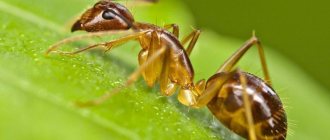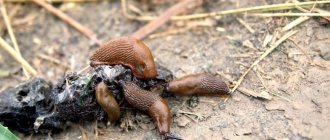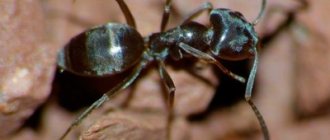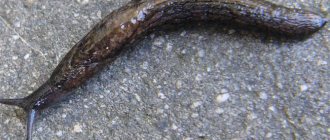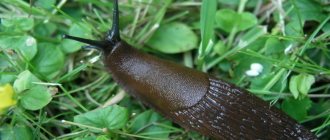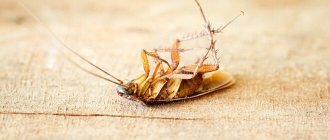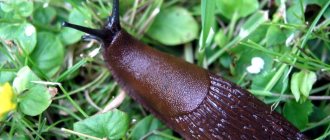Pest Control
Greetings. How to get rid of slugs in a greenhouse is a question that has been bothering me for some time. But, fortunately, I found my grandmother's old notes and there I found a solution to this problem. And I will tell you about my proven methods of fighting slugs: my grandmother’s and new ones that I learned. After all, a pest-free garden is the key to a good harvest.
Why am I fighting slugs in the greenhouse?
In my area, I sometimes notice the “naked slug” variety. The small mollusk settles not only in open areas, but also in greenhouses, cellars - wherever there is high humidity and shade.
Their harm to cultivated plantings is great - they love to feast on fresh, young plants with soft and succulent foliage. But plantings with hard tops are avoided. The most favorite food of gastropods is cabbage: white cabbage, broccoli, cauliflower, Peking cabbage, Brussels sprouts.
Therefore, in order not to lose the harvest, I begin to fight the pest as soon as the first individuals are found in the greenhouse. If the problem is neglected, voracious mollusks will fill the entire space of the greenhouse, destroying valuable plantings.
Preventive measures
The fight against slugs should begin as early as possible, and not after the discovery of the first chewed leaf or silvery mark. In early spring, you need to thoroughly loosen the soil and plant plants at the recommended intervals. Install as few shelves and drawers as possible, because these are where parasites hide. Carry out preventive, organizational, economic and agrotechnical measures on time. The area around greenhouses must be kept clean and weeds must be removed in a timely manner. And then the plants will be pleased with healthy leaves and a good harvest.
Signs of slugs in a greenhouse
I learn about the “adventures” of gastropods by their characteristic features:
- Damage only to soft, delicate plant tissues - eaten away spots and holes remain on the leaves.
- Silvery shiny traces remain along the route of the pests. You will see them on the leaves, on the soil, and on the walls of the greenhouse. Mucus is produced by gastropods to facilitate movement, as a protection against drying out of the body.
Having determined that slugs have settled in the greenhouse, I do not put off getting rid of them.
Electrical barriers
This method will not reduce the number of pests, but will only limit their access to plants and fruits. Therefore, electrical barriers are best used in greenhouses. Structurally, the barrier is a self-adhesive tape with exposed current conductors.
Electric barrier against slugs
Attention! The current strength and voltage in electrical barriers are so small that they are not that dangerous to humans; a person is not even able to feel the discharge.
The principle of operation of an electrical barrier is that when a slug or snail comes into contact with the conductors, they receive a small discharge, become confused and “change their mind” to move further towards the intended target in the form of a ripe squash or squash.
Chemical methods for getting rid of slugs in the garden
The fastest way to get rid of it is to use store-bought pesticides. But it has a lot of disadvantages:
- Destroys not only slugs, but also beneficial insects. Not safe for pets.
- A waiting period is required - early harvesting of greens can lead to serious poisoning.
- Chemicals are not safe for humans. It is better not to bring children to the site for approximately 5-7 days after treatment. The procedure itself must be carried out taking care of personal safety - wearing closed clothing and shoes, a respirator, and safety glasses.
- Part of the product will inevitably end up in the soil - the chemicals completely decompose within a month. Throughout this period, garden plantings will absorb toxic substances from the substrate.
Both complex (against all garden pests) and special formulations are effective against slugs. Among the most popular:
- "Storm";
- "Slug Eater";
- "Ferramol";
- "Predator";
- "Stopulit";
- "Bros Snakol";
- "Meta";
- "Schnecken Linsen."
A safer drug is special fertilizers. They do not contain toxic chemicals, but they contain substances that mollusks do not like. Among the most effective are calcined mineral fertilizers. But I only use them at stages when greenhouse plants really need feeding.
I do not recommend scattering dry mineral fertilizers over the garden bed in hopes of controlling slugs. Oversaturation of the substrate with calcium and salinization of the soil are no less harmful to plantings than an invasion of pests.
Another method I tried was iron sulfate. I sprinkle a little product on the migration routes of gastropods - they can be easily identified by their characteristic shiny trail. I also dust the perimeters of the beds. But I try to use fertilizer in reasonable quantities so as not to harm the plantings.
Iron sulfate is good because it does not lose its properties when exposed to sunlight or water. Does not wash off during heavy rains or watering. Slugs quickly die from contact with the substance before reaching the “feeder”.
iron sulfate against slugs
Physiology of the pest
A slug, or slug, is a naked mollusk covered in mucus. The upper horns contain eyes, the lower horns are used for palpating and recognizing the chemical composition of the intended food. Breathes through the pulmonary opening on the side. It leaves a wet trail behind, which turns silver when dry. Loves damp weather and moist soil in shady places, under stones, clods of earth, a layer of leaves. It begins to be active in the spring at +18-22 °C, degenerating from overwintered clutches.
Reaching maturity at 3-4 months, each individual manages to lay eggs more than once. It is predominantly nocturnal and emerges to feed around 11:00 pm. In rainy, damp weather it appears during the day.
Slugs have quite a few natural enemies: chickens, ducks, jackdaws, rooks, starlings, and some seagulls. Animals include hedgehogs, moles, shrews, toads, frogs; insects include ground beetles.
Food preferences are varied. According to statistics, slugs damage about 140 plant species. From the greenhouse assortment these are: tomatoes, cucumbers, peppers, eggplants, strawberries, white and cauliflower, lettuce, beans, peas. Juicy stems, leaves, fruits, underground parts of carrots, beets, and seedlings are attacked. Red cabbage, parsley, onions, and garlic suffer less from attacks.
Agrotechnical methods for getting rid of slugs
Effective and safe ways to eliminate uninvited guests from the site are useful agricultural techniques. I'll share what I use myself:
- Regulation of soil moisture. I wrote above that slugs prefer a consistently moist environment. You can combat them by adjusting the watering schedule - reduce water procedures as much as possible to create uncomfortable conditions for slugs. I use a little trick - after watering, I sprinkle the greenhouse beds with a thin layer of dry garden soil.
- Mulching. The delicate bodies of slugs will not like obstacles such as eggshells, wood chips, or sawdust. Mulch also optimizes the humidity of the substrate, absorbs moisture, remaining dry after watering, which is uncomfortable for mollusks. Slugs will also find any sharp, rough or rough surface of the mulch unpleasant.
- Attracting natural enemies. In the wild, slugs are a favorite food of frogs and hedgehogs. Attract animals to your property by building shelters for them.
- Planting “unpleasant” plants. From my own experience, I judge that slugs do not like the specific smell of lavender, thyme, laurel, parsley, rosemary, sage, and santolina. Therefore, I try to plant these crops around the perimeter of the greenhouse.
I find agrotechnical means to be preventive – in the event of an invasion, I turn to more radical methods of struggle.
Planting
By planting plants with a strong aroma in the garden, you can forget about the problem of slugs and snails. These pests do not tolerate some crops, so they will never appear in the area where they grow.
These plants include:
- Rosemary is officinalis. This seasoning perfectly repels a variety of garden pests. The leaves of the plant exude a bright and clean aroma that slugs cannot tolerate. They can be grown in open ground or pots; in the summer they are taken out into the garden and placed next to the beds where snails have been spotted.
- Parsley. It has a bright and rich aroma, as the leaves and other parts of the plant contain essential oils. Parsley effectively repels shellfish, so it is recommended to plant it next to crops that are subject to pest attacks.
- Thyme. The culture is one of the aromatic oil plants. Thyme is almost never attacked by pests, providing protection to neighboring plantings.
- Sage. This is an essential oil crop containing unique odorous biologically active substances. Thanks to its distinct spicy scent, sage repels slugs from garden beds.
- Basil. It has a pleasant aroma for humans, but slugs cannot tolerate this smell. The plant contains essential oils in the aerial parts.
- Lavender. The aroma of this plant is unpleasant and a strong irritant to slugs. It is enough to plant lavender in the garden and neighboring crops will not be attacked by pests.
- Yarrow. Due to the content of essential oils, the culture emits an aroma that is unpleasant for snails and slugs. Therefore, yarrow is, in most cases, grown as a repellent plant.
Traditional methods of fighting slugs in a greenhouse
I’ll also tell you about popular folk remedies, whose effectiveness I have verified through my own experience.
Spices
An excellent panacea for voracious shellfish is ordinary kitchen seasonings. I sprinkle spices on the surface of beds attacked by pests. The most effective is red pepper. But rosemary, cilantro, and black pepper are no less effective.
Small particles of seasoning irritate the delicate body of slugs, and sometimes leave serious burns, from which the mollusk dies. This scares pests away from the greenhouse and forces them to look for new habitats.
The disadvantage of this method is its short duration. Gastropods quickly develop immunity to spices - the offspring of surviving individuals already crawl freely over the obstacles of spices towards fresh foliage.
Beer
Like mole crickets, slugs are attracted to the smell of this alcoholic drink. So I use it to create a hook:
- I pour some beer into the bottom of glass or plastic jars.
- In the evening, I bury the containers in the greenhouse so that the neck is level with the surface of the earth.
- Since slugs are nocturnal, they will crawl towards the traps at night. In the morning I collect the “catch” by hand.
For several days in a row I replace the stale drink with a fresh one and fish out any pests from the cans. If you don't buy beer, you can replace it with kvass, fermented juice, jam or compote.
Plant traps
A simple, economical and safe method for removing slugs from greenhouses. Place fresh vegetable waste between the rows - I use cabbage leaves, tops of tomatoes, cucumbers, and lettuce.
To destroy as many pests as possible, I collect them early in the morning, before the sun hits the greenhouse. In this way, I “kill two birds with one stone” - wood lice often visit plant traps.
Another old-fashioned method is the use of old boards. In the evening, I grease one side of the wood with kefir, yogurt or another fermented milk product. I place it on two bricks or stones with the smeared side down and leave it in the greenhouse overnight. The slugs arrive to the aroma that is appetizing to them - in the morning all that remains is to collect the gastropods.
Salt
A fairly effective method of getting rid of shellfish is regular salt. It is sprinkled on the migration paths of pests and gastropods themselves. Salt corrodes their bodies and leads to death.
But I do not recommend that you get carried away with this method, especially on beds with cultivated seedlings. This will lead to salinization of the soil, making it unsuitable for farming.
How to get rid of slugs on flowers
Gastropods also love to eat decorative plantings. Hosts are especially attractive to them. I made an interesting observation: the pest gnaws the petiole of a leaf - it falls to the ground. The mollusk descends and climbs under the leaf, receiving both a “house” and provisions.
I fight slugs in the flower garden in the same ways:
- I make water traps - I dig containers of liquid level with the ground, adding it as it dries.
- I mulch the flower beds with peat, ash, sharp walnut shells, sand, coffee and tea.
- I struggle with shading and high humidity - I prune and tie up spreading plantings.
If there is a dominance of slugs, you can turn to chemicals - “Thunderstorm”, “Slug Eater”, “Predator” and so on.
How to get rid of slugs in the garden
Keep in mind that not only slugs can spread in the garden, but also pests similar to them, against which other methods are effective. Black “slugs” often crawl on pear and cherry leaves. These are actually the larvae of the slimy cherry sawfly. To combat them, it is better to use Kinmiks. "Bitoxibacillin", "Inta-Ts-M".
When real slugs appear in my garden, I solve the problem by building a simple trap:
- I take an ordinary plastic cup and put a treat on the bottom - juicy grass, beer, pieces of fresh vegetables, cabbage.
- I lower a tube into the container through which the mollusk could easily crawl through. But in such a way that it does not touch the bottom of the glass.
- The easiest way is to pass the tube through a tight lid, make a hole in the latter, and seal the glass tightly. If there is no lid, then the container can be closed with tape, adhesive tape, cling film - so that there are no other entrances in the glass except the tube.
- I bury the glass up to the neck in the soil. I lower the tube level with the surface of the earth so that the slug can easily climb into it.
The trap is ready - the pest, sensing the bait, will climb into the cup, from where there is no exit. All I have to do from time to time is collect the mollusks I come across and refresh the bait.
I don’t forget to check the cellar in the garden house:
- I arm myself with a bucket of water and a flashlight and collect pests from the walls by hand.
- In the fall, when there are no supplies in the cellar, I dust the walls, floor, and ceiling with a mixture of chalk and ash. If there is an invasion of gastropods in the storage facility, it is more effective to use a sulfur bomb.
Another simple and safe trap is pieces of linoleum, roofing felt, old boards, plastic, and a bunch of plant debris. Any shelter that will be attractive must be damp, dark and warm. All I can do is lift the traps from time to time and collect hidden mollusks from there.
slug trap
Living enemies
In nature, slugs and snails have natural enemies. They can become reliable assistants in pest control. But to do this, you will first have to attract them to the site.
Will help get rid of slugs and snails:
- Starlings. Place several birdhouses on the site. At first, make sure that the feeders contain food for birds that will attract them. Gradually, starlings will begin to independently look for food for themselves.
- Lizards. They actively feed on slugs and snails. To attract them to your garden, place decorative stones that will not only provide decoration, but also provide shelter for the lizards.
- Frogs. There should be at least a small pond on the site. This is a habitat for frogs and a wonderful decoration for the site.
- Ground beetles. These are dangerous, fast and predatory insects. Ground beetles require certain living conditions. They prefer to settle in damp depressions, where they dig comfortable burrows for themselves. Not only adult insects, but also their larvae are very bloodthirsty. They feed on smaller slugs, fly larvae, caterpillars and wireworms. The larvae live in damp mulch and hunt there.
Birds, lizards, frogs and insects settle only in those areas where various chemicals are not actively used.
Preventing the appearance of slugs in the greenhouse
Although I know how to quickly and easily remove pests from a site, I still try to prevent their appearance:
- I make sure the garden is well-groomed and clean. “Plantations” of weeds are an excellent place for life and reproduction, from where they spread throughout the entire garden, including greenhouses. I don’t allow heaps of plant waste to form where it’s dark and humid – I store it in time and burn it. I don’t forget to thin out cultivated plants - the abundance of side shoots and constantly moist soil attract gastropods.
- I do not practice continuous, thickened plantings. This environment is the most comfortable for slugs. They exist in optimal humidity, protected from the sun, and have unlimited access to foliage. I thin out the plantings, remove unnecessary lower branches, ensure good aeration in the greenhouse - I periodically ventilate the greenhouse.
- I do not allow pests near food sources. Slugs do not fly and do not dig underground passages, which is why it is quite easy to build barriers for them. Protect the ridges with slippery plastic panels or sheets of iron with sharp edges, burying them 3-5 cm into the ground. If you have children, it is better to replace such traumatic obstacles with small ditches with nut shells or eggshells - slugs will not be able to overcome such protection.
- I mulch the beds. I try to cover the ground around plants attractive to slugs with a thin layer of sawdust, fine sand, gravel, and broken shells. Tiny particles of mulch stick to the clam's wet body, preventing it from moving toward food. Ash acts in a similar way. I spread a protective layer of ash around the plantings. Sticking to the bodies of slugs, it irritates and burns their integument.
- Watering with warm water. The method is good only for cabbage plantings - it can harm other crops. Gastropods do not like to settle in beds that are watered with water heated to 40-50 C.
Eliminating slugs from your site is not an easy task, but it can be done. Conventional manual harvesting, agrotechnical techniques, and folk methods are also effective here. If the pest is dominant, use pesticides after weighing the pros and cons. But the easiest way is to turn to prevention in order to prevent the appearance of harmful gastropods in the garden.
Manual collection
This is the most effective and easiest way to get rid of slugs and snails. Collection is carried out manually. It is better to do this in the evening, when the sun has set, or in cloudy weather, after rain in damp places. At this time, pests leave their shelters. The activity is tedious, but brings tangible results.
Be sure to check the bottom and back of the leaves. All pests are placed in a bucket pre-filled with soapy water. You can collect with your hands, wearing gloves, or use tweezers.
